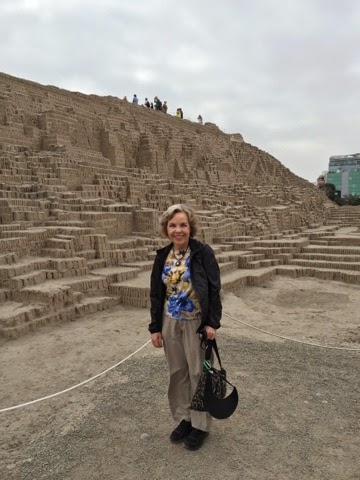This day was dedicated to exploring Lima's history, culture and religion.
We started off on a bus tour of the city with a lovely young tour guide named Vanessa who told us some more interesting facts about the city.
Although it is situated on the Pacific coast, the city's beaches are not very useable. They are narrow and stony. Secondly, the water is very cold and is only 56 degrees year round. This is due to a current that flows from Antartica. Surfers love the waves here but they all wear wet suits.
Our first stop was to Larco Museum. We were supposed to go to the Archeological Museum but it is closed on Mondays. This is a private museum run by a wealthy family who collected many artifacts from the previous centuries. Much of it was pottery. Our guide pointed out that people lived here 16,000 years ago but only had pottery as of 4,000 years ago. Even then, much of it was used for religious ceremonial purposes rather than everyday life. We saw a few interesting pieces from pre-Columbian times.
There were only a few textiles, but one was of particular interest. It was a small piece, about 3" x 6" and made with vicuña thread. The thread count was 300 stitches to an inch! I did read that from 1300-1500 AD, weavings were considered as valuable as gold and silver.
We also saw a "quipus," which was an accounting system using cords and knots. Some say it might resemble the binary code system but no one knows for sure. Unfortunately, the Spanish burned most of them.
There were also exhibits of gold and silver, especially some used in burials. Included was a Huari mummy of a 5-year-old child from the 8th century which has never been opened.
Our tour ended at the Erotica Museum with items from the Moche period. The natives celebrated their sexuality and made sculptures depicting various sexual acts.
From the Larco, we took the bus to the center of Lima where we visited The San Franciscan Monastery. Noteworthy about this site was a trip through the underground catacombs containing the crypts of wealthy people up to the early 19th century.
Then we walked along the city streets to the Plaza Mayor. Along the way we were stopped by several women in traditional Andean attire selling "chicklets" (gum) and other trinkets. (Notice the child on her back.)Then I saw a very tired
musical group waiting to give another street performance. It made me think about what Pepe said about "informal" work. Everyone has to do something to eat. Peru has no welfare.
The Plaza Mayor was beautiful with its large open square and flanked by the Cathedral of Lima, the President's residence and other neo-colonial buildings.
We returned to the hotel for lunch on our own.
Then at 3, Pepe took some of us to Huaca Pucllana, a massive pre-Inka Adobe pyramid site. Built by the Limoans between 200 and 700 AD, it was just used for religious ceremonial purposes and the people lived around it. The construction was composed of flat hand-formed bricks that were dried in the sun and then stacked vertically. A layer of mud was spead over the stacked bricks and another layer was added. The preservation and restoration of this site has only been going on since 1981. It is a massive site but was once much bigger.
Tonight we went to a restaurant for a traditional Peruvian meal and to watch some dancing.












No comments:
Post a Comment